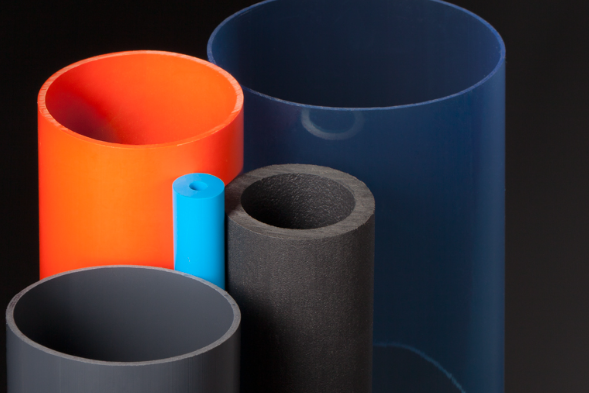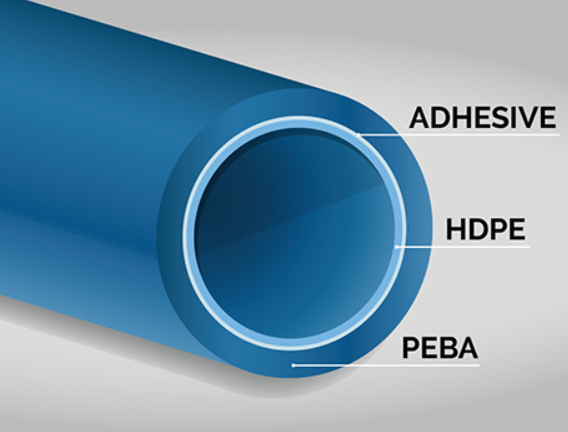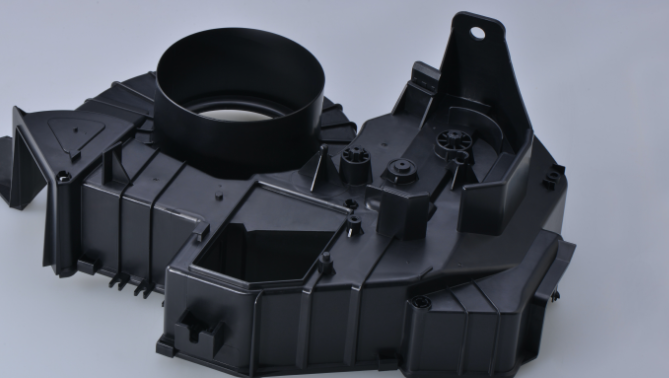Fundamentals of Wall Thickness in Extrusion
Understanding wall thickness in plastic extrusion is crucial as it impacts the strength, flexibility, and durability of the final product. The right thickness ensures the product performs as intended without wasting material.
Definition of Wall Thickness
Wall thickness refers to the distance between the outermost surfaces of the extruded profile. It is a key design parameter that determines the structural integrity of the product. In plastic extrusion, maintaining uniform wall thickness can be the difference between a quality product and a manufacturing failure.
- Uniformity: A consistent wall thickness is easier to produce and maintain structural integrity.
- Measurement: Wall thickness is typically measured in millimeters or inches, using tools like calipers or specialized measuring devices.
Factors Influencing Wall Thickness
Several factors contribute to the determination of wall thickness in the extrusion process, each playing a vital role in the final product’s performance.
- Material Flow: The flow characteristics of the plastic material dictate how it fills the die, affecting the achievable wall thickness.
- Die Design: The design of the extrusion die must facilitate even flow of the molten plastic to achieve the desired wall thickness.
- Cooling Rate: How quickly the extruded plastic cools can affect wall thickness uniformity. Rapid cooling might cause uneven thickness due to shrinkage.
- Extrusion Speed: Faster extrusion can lead to inconsistencies in wall thickness, while slower speeds may improve uniformity but reduce production efficiency.
- Material Properties: Different plastics have unique properties, such as viscosity and thermal stability, which influence the minimum and maximum wall thickness that can be reliably produced.
Minimum Wall Thickness: Materials Consideration
When determining the minimum wall thickness for plastic extrusion, the material plays a pivotal role. Materials not only influence the product’s functionality but also its manufacturability and cost-effectiveness.
Material Properties and Wall Thickness
Each material’s unique properties directly impact the minimum wall thickness achievable in the extrusion process. For instance:
- Strength and Rigidity: High-strength materials can maintain structural integrity at lower thicknesses, potentially reducing material usage and costs.
- Thermal Stability: Materials with high thermal stability can withstand the extrusion process without deforming, allowing for thinner walls.
- Viscosity: Lower viscosity materials may require thicker walls to prevent sagging or collapse during cooling.
Selecting the right material involves balancing properties such as strength and flexibility with the extrusion process’s power requirements and efficiency. For example, a high-power extrusion setup can handle materials with greater viscosity, which could improve the product’s quality but might also increase production costs.
Commonly Used Plastics and Their Thickness Requirements
Different plastics come with their own set of thickness requirements based on their properties:
- Polyethylene (PE): Often used for its toughness and ductility. Minimum wall thickness for low-density PE can be as thin as 0.6mm, allowing for a balance between durability and material cost.
- Polypropylene (PP): Known for its excellent chemical resistance and weldability. PP typically has a minimum wall thickness of around 0.8mm to ensure product stability and performance.
- Polystyrene (PS): Chosen for its rigidity and ease of processing. For general-purpose PS, the minimum wall thickness might be set around 1mm to prevent brittleness.

Designing for Optimal Wall Thickness in Plastic Extrusion
Creating the ideal wall thickness in plastic extrusion demands thorough planning and precision. Designers must consider how the wall thickness will affect the product’s dimensions, quality, and performance throughout its lifespan.
Design Considerations for Wall Thickness
When designing for optimal wall thickness, several critical factors require attention:
- End-Use Requirements: Identify the mechanical loads and environmental conditions the product will face. If a part needs to withstand significant impacts, a thicker wall may be necessary, while a component that must flex could perform better with a thinner wall.
- Material Selection: Different materials will dictate the wall thickness. For example, polycarbonate might allow for thinner walls due to its strength compared to polyethylene.
- Manufacturing Efficiency: Strive for the thinnest wall that meets the product’s needs to minimize material usage and reduce costs. If extrusion speed is a priority, ensuring the wall thickness supports a faster throughput without compromising quality is essential. A difference in wall thickness of just 0.1mm can alter the speed, with thinner walls allowing for quicker production cycles.
Using CAD Tools for Wall Thickness Design
Computer-Aided Design (CAD) tools are instrumental in modeling and simulating the extrusion process before actual manufacturing:
- Precision and Specifications: CAD allows for precise control over wall thickness, enabling designers to specify exact dimensions down to fractions of a millimeter.
- Simulation: By simulating the extrusion process, designers can predict how the material will behave, allowing for adjustments in wall thickness before costly prototypes are made.
- Optimization: CAD software can optimize the design for both performance and cost, potentially reducing the material by a percentage that translates directly into budget savings.
Manufacturing Constraints Affecting Wall Thickness
In plastic extrusion, certain manufacturing constraints directly impact the wall thickness of the products. Understanding these limitations helps in optimizing the design to balance quality, cost, and production efficiency.
Equipment Limitations
Extrusion equipment has specifications that determine the minimum and maximum wall thickness it can produce:
- Extruder Capacity: The size and capability of the extruder can limit how thin or thick the walls can be. For example, an extruder with a 90mm screw diameter may not effectively process wall thicknesses below 0.5mm due to its power output and pressure generation capabilities.
- Die Design: The complexity of the die design influences the achievable wall thickness. A die with intricate details may not support walls thinner than 1mm without risking defects.
- Cooling Systems: The efficiency of the cooling system affects how quickly a product cools and solidifies, which can impact wall thickness uniformity. If the cooling is uneven, the wall thickness might vary across the product, leading to quality issues.
Process Variables Impacting Wall Thickness
The extrusion process involves several variables that must be finely tuned to achieve the desired wall thickness:
- Material Throughput: The rate at which material is fed through the extruder affects wall thickness. A higher throughput might increase the wall thickness, while a lower throughput could make it difficult to maintain the minimum wall thickness over large production runs.
- Screw Speed: The rotational speed of the screw affects how the material is mixed and pushed through the die. An optimal screw speed needs to be maintained to ensure consistent wall thickness; too fast could cause uneven thickness, too slow could reduce production speed, impacting efficiency and costs.
- Temperature Settings: Precise temperature control is critical. If the material’s temperature is too high, it may result in walls thinner than intended due to material run-off; too low, and the material might not flow correctly, leading to thicker walls.
Industry Standards for Wall Thickness
The production of extruded plastic products must adhere to certain industry standards to ensure safety, performance, and interoperability. These standards provide guidelines for wall thickness based on the intended use of the product and the material used.
International Standards for Extruded Products
Several international bodies set the benchmarks for the wall thickness of extruded products, taking into account global best practices:
- ISO Standards: The International Organization for Standardization (ISO) provides detailed guidelines for various materials and applications. For example, ISO 12091 sets out specifications for the minimum wall thickness for extruded thermoplastics.
- ASTM Standards: The American Society for Testing and Materials (ASTM) offers standards such as ASTM D3567, which prescribes wall thickness for different types of plastic pipe systems.
- EN Standards: European Norms (EN) also offer directives, like EN 13476, detailing requirements for plastic piping and ducting.
Complying with these standards often means meeting specific numerical parameters. For instance, ISO standards might specify that a particular type of polyethylene pipe should have a minimum wall thickness of 2.3mm to ensure durability and performance under pressure.
Compliance and Quality Assurance
Adhering to industry standards is not only a legal requirement but also a mark of quality and reliability:
- Certification Processes: Manufacturers must undergo rigorous testing and certification processes to demonstrate compliance. This might involve measuring wall thickness at various points along the extrusion to ensure it falls within the tolerances set by the relevant standard.
- Quality Control Protocols: Establishing in-house quality control protocols is essential for consistent compliance. This may include regular audits and checks to verify that the wall thickness of extruded products remains within specification, which could be as tight as +/- 0.05mm for some high-precision applications.

Calculating Minimum Wall Thickness for Different Plastics
Determining the appropriate minimum wall thickness for plastic extrusion products is a critical step in ensuring both functionality and material efficiency. Various calculation methods are used to find the optimal thickness for different plastics.
Wall Thickness Calculation Methods
The calculation of wall thickness takes into account several key factors:
- Material Strength: Each plastic has a characteristic tensile strength which dictates how much force it can withstand. This is often the starting point for calculating the wall thickness.
- Safety Factors: Designers apply safety factors to account for unknowns and variables in material behavior. This factor can vary based on industry and application, but typically ranges from 1.2 to 1.5 times the calculated stress.
- Load Conditions: The expected load and its nature – whether it’s static or dynamic – play a significant role in determining wall thickness.
- Manufacturing Tolerances: These are allowances made for variations in production and material inconsistencies. They are crucial for ensuring that the final product meets specifications even with slight deviations during manufacturing.
Examples of Thickness Calculations for Various Plastics
- Polyethylene (PE): A high-density PE with a tensile strength of 31 MPa may require a wall thickness of 5mm for a pipe carrying water at 5 bar pressure, considering a safety factor of 1.25.
- Polyvinyl Chloride (PVC): For a PVC pipe with a tensile strength of 52 MPa under the same pressure, the wall might only need to be 3mm thick due to its higher material strength.
- Polycarbonate (PC): With a tensile strength of 70 MPa, a PC component may have a calculated minimum wall thickness of 2mm for a similar load, offering a thinner yet durable solution.





